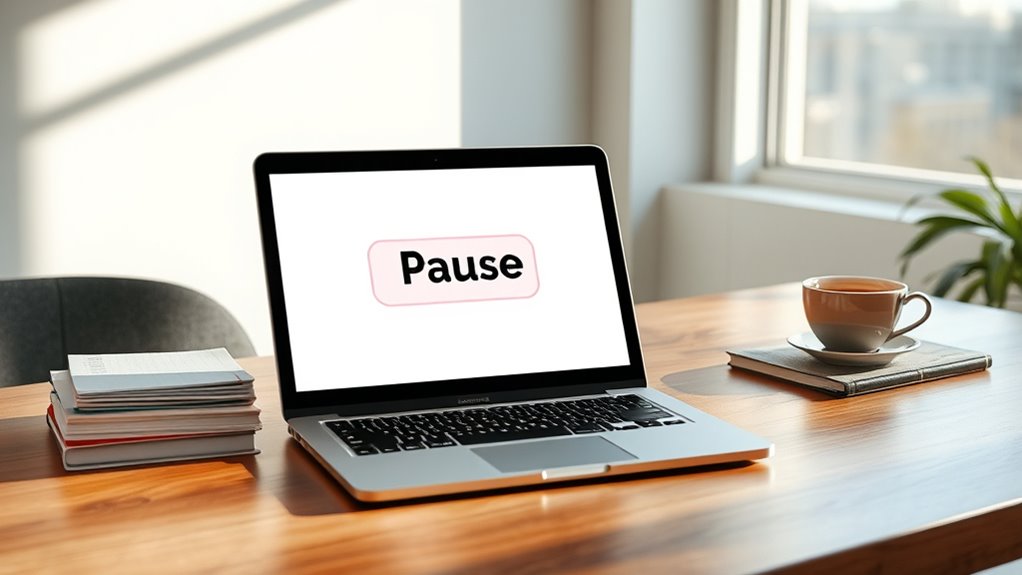Before hitting send, take a moment to pause and reflect on your email. Rushing can lead to misunderstandings, hurt feelings, or unintended consequences. Use a personal checklist, read your message aloud, and consider your tone and emotions. Practice empathy and add time delays or drafts to guarantee clarity and professionalism. Cultivating these mindful habits helps you communicate more effectively and thoughtfully—if you want to discover more strategies, continue exploring the technique of mindful emailing.
Key Takeaways
- Incorporate a deliberate pause to review tone, clarity, and emotional impact before sending emails.
- Read emails aloud to catch awkward phrasing and ensure your message is respectful and clear.
- Clarify your intent and consider the recipient’s perspective to prevent misunderstandings.
- Add a time delay or draft the message first to reassess and refine your communication.
- Practice mindfulness habits like deep breathing and intentional pauses to foster thoughtful, respectful emailing.
Recognizing the Impact of Hasty Emails

Have you ever sent a hurried email only to realize afterward that it caused confusion or offense? If so, you’re not alone. When you rush, it’s easy to overlook tone, word choice, or context, making your message misinterpreted. Hasty emails often lack clarity, leaving the recipient unsure of your intent. They can spark misunderstandings, hurt feelings, or even damage relationships. Sometimes, a quick reply seems necessary, but it can backfire if you don’t pause to think. Recognizing the impact of rushing helps you see how impulsive messages can escalate problems rather than resolve them. By understanding that your words carry weight, you become more aware of the importance of taking a moment before hitting send. Additionally, considering mindfulness techniques can help you better assess the tone and clarity of your messages, ensuring they are visually and contextually appropriate before sending. This mindful approach can also prevent potential financial disputes that might arise from miscommunication or misunderstandings.
Creating a Pause: The Power of the Moment

Why is taking a moment before replying so powerful? It gives you time to assess your emotions, clarify your message, and prevent impulsive responses. This simple pause can transform a rushed email into a thoughtful, respectful message. It helps you catch mistakes, soften harsh language, and ensure your tone aligns with your intentions. To illustrate, consider this table:
| Situation | Immediate Reaction | Paused Response |
|---|---|---|
| Receiving criticism | Defensive, dismissive | Calmly acknowledge, respond thoughtfully |
| Emotions running high | Anger, frustration | Take a breath, find a neutral tone |
| Confusing message | Frustration, confusion | Clarify before replying |
| Sensitive topic | Anxiety, hesitation | Reflect, choose words carefully |
| Busy schedule | Rushed, careless | Delay, craft a deliberate reply |
Creating a pause enables you to communicate more effectively and mindfully. Incorporating this practice can also help you navigate complex regulatory compliance issues effectively, ensuring your responses are both respectful and aligned with legal standards. Developing these skills enhances your ability to handle conflict resolution more gracefully and thoughtfully. Additionally, practicing this mindful approach can contribute to improving your overall communication skills and emotional intelligence. Recognizing the importance of effective communication can further enhance your ability to handle sensitive situations with care and professionalism.
Developing a Personal Email Checklist

Creating a personal email checklist is essential for guaranteeing your messages are clear, respectful, and effective. Start by reviewing your email’s purpose—are you informing, requesting, or confirming? Check that your tone matches the situation, remaining professional and polite. Affirm all recipient addresses are correct to avoid miscommunication. Read through your message to ensure clarity—are your points straightforward? Remove any unnecessary words or jargon. Double-check for typos, grammatical errors, and tone issues. Ensure your subject line accurately reflects the content. Consider whether your email is concise yet complete. Before hitting send, ask yourself if the message aligns with your intentions and maintains respect for the recipient. Developing this routine helps you communicate intentionally and thoughtfully every time.
Reading Your Email Aloud for Clarity

After reviewing your email with your personal checklist, reading it aloud can reveal issues that silent reading might miss. When you speak the words, you catch awkward phrasing, unclear sentences, or misplaced emphasis. It helps you notice if your message flows naturally and if your tone matches your intent. You might discover run-on sentences or confusing details that aren’t obvious when reading silently. This practice also highlights areas where your wording could be more concise. Additionally, reading aloud can help you identify tuning issues or ambiguities that might affect how your message is received. By hearing your email, you ensure your message is clear and easily understood. It’s a simple step that minimizes misunderstandings and helps you communicate more effectively. Regularly reviewing your message for clarity and accuracy can further enhance the quality of your communication. Incorporating a quick review process like reading aloud allows you to catch errors early and refine your tone. Taking these moments to read aloud before hitting send ensures your email is polished and intentional.
Considering Your Tone and Intent

Have you ever contemplated how your tone and intent shape the way your email is received? Your choice of words, phrasing, and overall attitude set the stage for how others interpret your message. Even if you mean well, a sarcastic or abrupt tone can lead to misunderstandings or defensiveness. Before hitting send, ask yourself what impression you want to leave. Are you aiming to inform, request, or resolve? Make sure your language aligns with that goal. Be mindful of how your words might sound—friendly, professional, or firm—and adjust accordingly. Clarify your intent to prevent miscommunication and foster positive interactions. Taking a moment to consider your tone makes your message clearer and helps build stronger connections. Recognizing the importance of tone and intent in communication can significantly improve how your message is perceived. Additionally, understanding the impact of family dynamics can shed light on personal interactions and influence your communication style. Practicing stillness can also help you gain better control over your emotional responses, leading to more thoughtful messaging. Incorporating a moment of pause before sending emails allows for reflection on self-awareness, ensuring your tone aligns with your true intentions.
Managing Emotions Before Sending

Before hitting send, take a moment to recognize what might be triggering strong emotions in you. Pause and reflect on why you’re feeling this way, giving yourself time to respond thoughtfully. Managing your emotions helps guarantee your message stays clear and professional. Incorporating positive energy can also help you approach your message with a calm and constructive mindset. Additionally, practicing mindfulness during this pause can deepen your awareness of your emotional state and promote emotional regulation, which is essential for maintaining emotional balance during stressful interactions. Recognizing signs of emotional distance or irritation, as seen in warning signs of a checked-out partner, can further aid in maintaining a balanced perspective.
Recognize Emotional Triggers
Recognizing your emotional triggers is a crucial step in mindful emailing, especially when strong feelings threaten to cloud your judgment. You might notice certain words, topics, or situations that consistently provoke frustration, anger, or defensiveness. By identifying these triggers, you become more aware of how your emotions influence your responses. When you recognize these signals, you can take a moment to pause and assess whether your feelings are justified or if they’re clouding your judgment. This awareness helps you avoid impulsive reactions that might escalate conflicts or lead to misunderstandings. Over time, understanding your triggers empowers you to approach sensitive emails with greater objectivity and calmness, fostering more thoughtful and respectful communication. Additionally, being aware of automation in business can help you maintain professionalism and clarity in your digital interactions. Being mindful of your emotional response patterns allows you to develop healthier communication habits and reduce unnecessary conflicts. Recognizing these patterns can also help you identify behavioral cues that signal when your emotions are influencing your decisions, enabling you to respond more thoughtfully. Developing this awareness can also improve your overall digital literacy, helping you navigate online interactions more effectively and confidently.
Pause and Reflect
When you feel emotional tension rising during email composition, taking a moment to pause and reflect can make all the difference. Instead of rushing to hit send, step back for a few seconds. Ask yourself if your message truly represents what you want to communicate or if your emotions are influencing your words. Consider how your tone might be perceived and whether the email could be misunderstood. Reflect on whether you’re addressing the issue constructively or reacting impulsively. This brief pause allows you to gain clarity, reduce defensiveness, and approach the situation with a calmer mindset. Recognizing the impact of emotions on communication can help you make more mindful choices. Additionally, understanding how income variability can influence your financial perspectives may encourage a more balanced emotional approach to professional interactions. Being aware of regional legal resources can also help you better navigate potential conflicts or misunderstandings. Furthermore, incorporating mindful communication techniques can enhance your overall effectiveness and reduce misinterpretations. By managing your emotions before sending, you’re more likely to foster understanding and maintain professionalism, ultimately strengthening your communication and relationships.
Practicing Empathy and Perspective

Practicing empathy and perspective in your email communication requires actively putting yourself in the recipient’s shoes. Before sending, consider how your message might be received—what tone, intent, or emotion it conveys. Ask yourself if your words could be misunderstood or if they might unintentionally upset or confuse the reader. Think about their workload, deadlines, or stress levels; this awareness can help you craft more considerate and respectful messages. Avoid assumptions and be clear about your intentions, making it easier for others to understand your perspective. By approaching emails with empathy, you foster better relationships, reduce miscommunication, and create a more positive, collaborative environment. Remember, a little perspective goes a long way in mindful emailing. Additionally, understanding the power of instant feedback can help you gauge how your message might be perceived before hitting send.
Implementing Time Delays and Drafts

By adding time delays before sending emails, you give yourself a moment to reconsider your tone and content. Drafting messages first helps you clarify your thoughts and avoid misunderstandings. These simple steps can make your communication more intentional and effective. Incorporating storage practices can also provide insight into how others perceive your messages or offers.
Benefits of Delaying
Implementing time delays and drafts can considerably improve the quality of your emails. By pausing before sending, you give yourself space to reflect on your message’s tone and content, reducing impulsive or emotional replies. Delays help you spot mistakes, clarify your thoughts, and ensure your message aligns with your intentions. Taking a moment also allows you to contemplate how your email might be received, fostering more thoughtful communication. Over time, this practice reduces misunderstandings and improves relationships. It encourages you to prioritize quality over speed, making your emails more professional and respectful. Ultimately, delaying your send button supports better decision-making, helping you craft clearer, more considerate messages that positively impact your interactions.
Drafting for Clarity
Have you ever sent an email only to realize later that your message was unclear or confusing? To prevent this, take a moment to draft your email carefully. Focus on clarity by organizing your thoughts beforehand. Use simple language and short sentences to make your message easy to understand. After writing, step away for a few minutes or even hours if possible. Coming back with fresh eyes helps you spot ambiguities or errors. Consider reading your email aloud; it reveals awkward phrasing or unclear points. Using drafts and delays encourages you to refine your message, ensuring it’s precise and effective. Taking these steps reduces misunderstandings and makes your communication more professional and respectful.
Cultivating Mindfulness Habits for Better Communication

Ever wonder how small, consistent habits can transform your communication? Cultivating mindfulness habits helps you become more aware of your thoughts, emotions, and responses before sending emails. Start by setting intentional pauses—take a deep breath or review your message after drafting. Develop a routine, like checking in with yourself about tone and clarity before hitting send. Practice active listening in your interactions to better understand others’ perspectives. Incorporate brief mindfulness exercises, such as grounding or mindful breathing, into your daily routine. Over time, these habits sharpen your awareness, reduce impulsiveness, and foster more thoughtful, respectful communication. Consistent effort builds a habit of mindfulness that enhances your relationships and prevents misunderstandings. Small, deliberate actions create lasting improvements in how you connect with others.
Frequently Asked Questions
How Can I Tell if My Email Needs Urgent Attention?
When determining if your email needs urgent attention, consider the sender’s tone and the content’s urgency. Look for keywords like “immediate,” “urgent,” or “as soon as possible.” Check if the message involves a deadline or critical issue. If it’s time-sensitive or impacts others’ work, respond promptly. Trust your instincts—if it feels important or pressing, prioritize it and reply without delay.
What Are Signs I’M Feeling Emotional When Typing?
Imagine your emotions are a storm brewing inside as you type. If your words feel sharp like lightning or heavy like thunder, you’re likely feeling emotional. You might notice your hands trembling, your heart racing, or your thoughts racing faster than your fingers. These signs show your feelings are influencing your message. Take a deep breath, pause, and give yourself time to calm the storm before hitting send.
How Often Should I Implement Email Pauses During the Day?
You should implement email pauses throughout your day whenever you feel overwhelmed, upset, or rushed. Aim to pause for a moment before drafting, editing, or sending emails, especially during stressful or emotional moments. This helps you gain clarity and avoid impulsive responses. A good rule is to pause at least once every hour or after composing emotionally charged messages. Regular pauses promote thoughtful, professional communication and reduce misunderstandings.
Can Mindfulness Improve Overall Workplace Communication?
Mindfulness can notably improve your workplace communication. When you practice being present and attentive, you become more aware of your tone and message, reducing misunderstandings. It helps you listen better, respond thoughtfully, and manage stress during interactions. Incorporating mindfulness into your daily routine allows you to communicate more clearly and empathetically, fostering stronger relationships and a more positive work environment.
What Tools Can Help Automate the Pausing Process?
Your inbox is a battlefield, and automation tools can be your secret weapon. Tools like Outlook’s Delay Delivery, Gmail’s Schedule Send, or apps like Boomerang and SaneBox let you set your emails to pause before sending. These tools act like a mindful pause, giving you time to review, avoid mistakes, and communicate thoughtfully. Use them to turn your email habits into a calm, deliberate practice.
Conclusion
Taking a moment before hitting send might feel like an extra step, but it can save you from misunderstandings and regrets. Even if you’re busy, pausing helps you communicate more thoughtfully and confidently. Remember, mindfulness isn’t about slowing down endlessly—it’s about making intentional choices that strengthen your relationships and reputation. So, next time, give yourself that pause. It’s a small change with a big impact on how your message is received.









